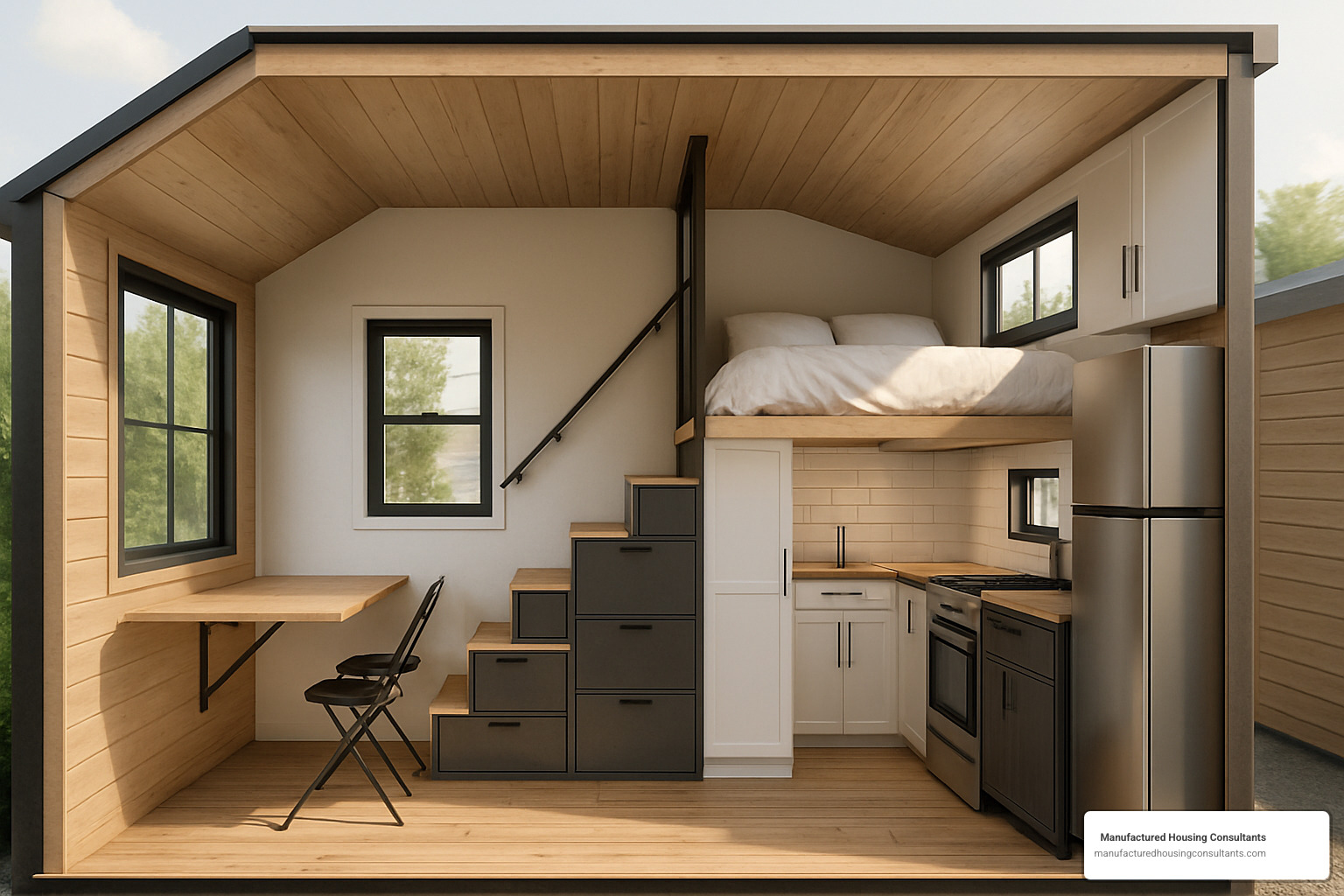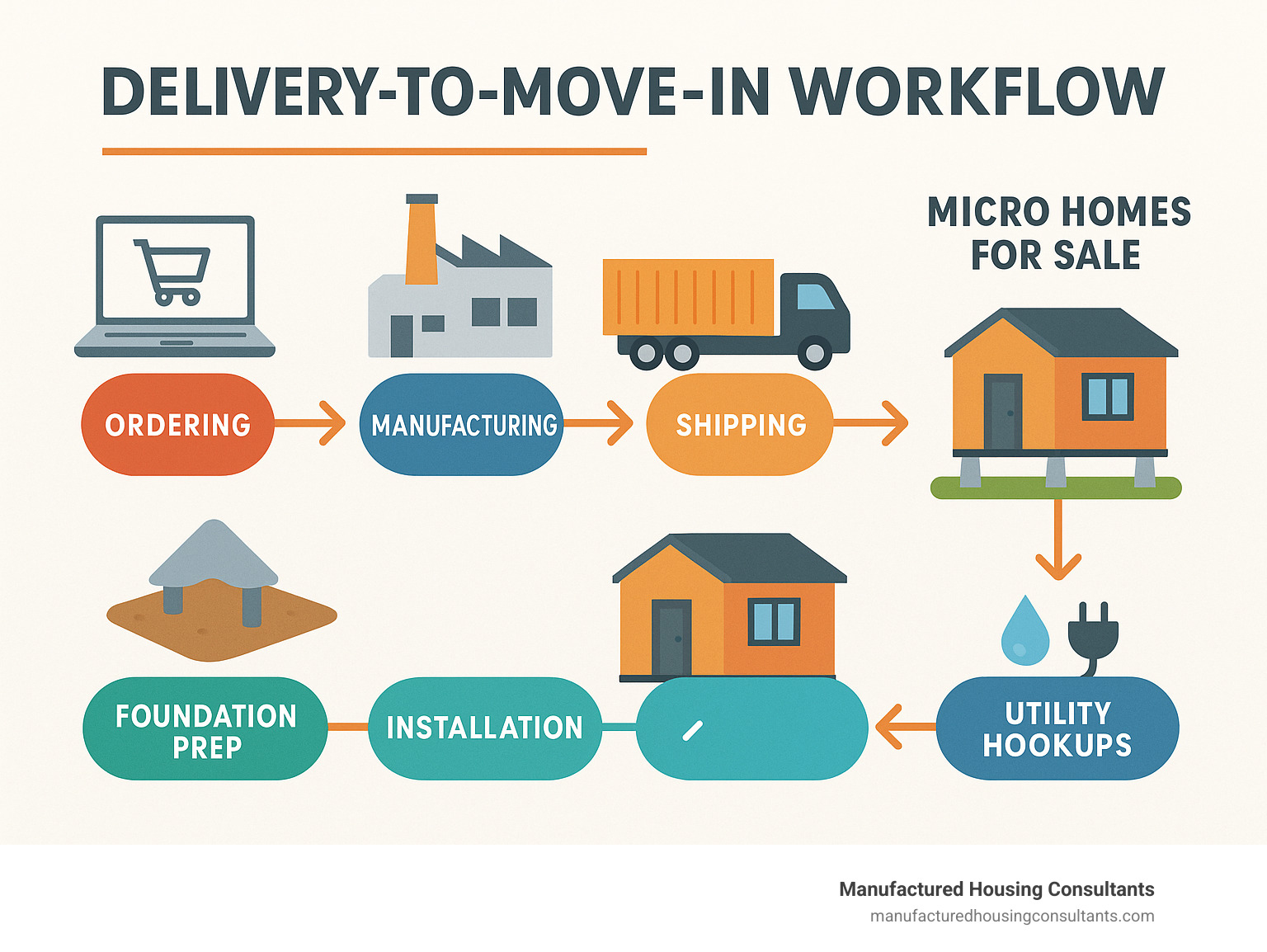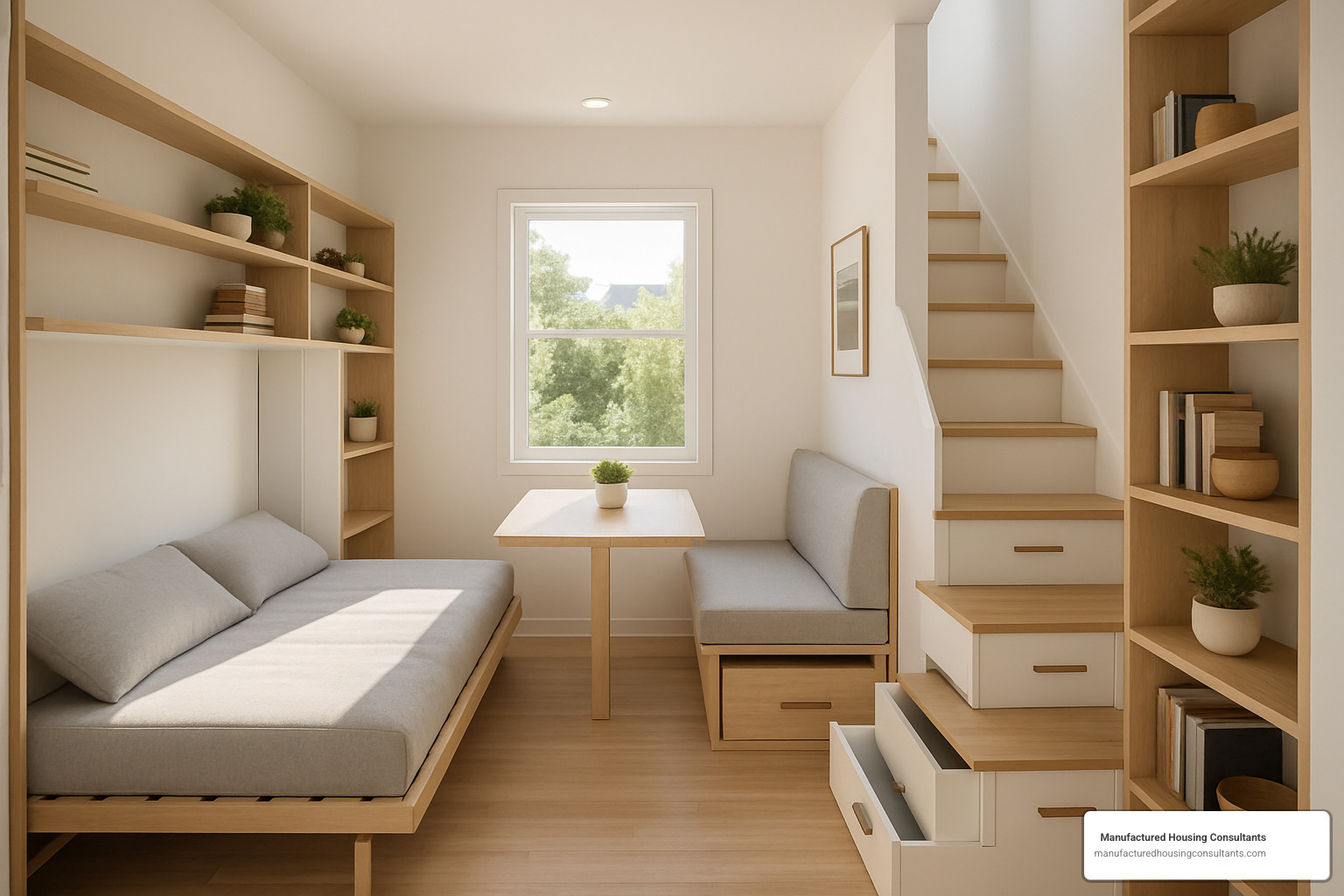The Rise of Micro Home Living
The tiny house movement isn’t just a trend anymore—it’s becoming a genuine housing revolution. Micro homes for sale are capturing the hearts and minds of Americans looking to simplify their lives without sacrificing comfort or style. As traditional housing costs continue to climb into the stratosphere, these compact dwellings offer a breath of fresh air (and significant financial relief).
When you’re exploring the micro home market, here’s what you can expect at a glance:
| Key Information | Details |
|---|---|
| Price Range | $2,955 to $52,999 (most popular models: $10,000-$30,000) |
| Typical Size | 100-400 square feet (some expandable models reach 1,200+ sq ft) |
| Common Types | Prefab, modular, container homes, expandable models, and tiny houses on wheels |
| Delivery Time | Typically 2-6 weeks for prefab models |
| Popular Features | Space-saving furniture, lofted bedrooms, multi-purpose areas, off-grid capabilities |
I’ve watched families transform their lives by downsizing to these clever little spaces. One young couple I worked with managed to eliminate their mortgage entirely by investing in a beautiful 320-square-foot micro home that cost less than their previous down payment would have been.
“We believe tiny homes offer incredible advantages for those ready to simplify their lives,” a manufacturer recently told me, and I couldn’t agree more. There’s something deeply satisfying about a space where everything has its purpose and place.
The versatility of these homes is truly remarkable. Whether you need an affordable primary residence that won’t break the bank, a stylish backyard office for your growing remote career, a cozy guest house for visiting family, or even a potential rental income source, micro homes for sale can adapt to your life rather than forcing you to adapt to them.
Today’s tiny home designs have come a long way from the bare-bones models of years past. Modern micro homes include full kitchens with apartment-sized appliances, surprisingly spacious bathrooms (some even with tubs!), comfortable sleeping areas, and ingenious storage solutions that make you wonder why your traditional home wasted so much space.

What I love most about today’s micro home market is the incredible variety. You can choose from ready-to-move-in models delivered straight to your property, DIY kits if you’re handy with tools, or fully customized builds custom to your exact specifications and lifestyle. Many are designed for permanent foundations, while others come with wheels for those who dream of changing their backyard view whenever the mood strikes.
Curious about specifics? Here are some resources to help you dive deeper:
- Wondering about budgeting? Check out how much do tiny homes cost for a detailed breakdown
- Looking for layout inspiration? Our collection of small home floor plans showcases clever designs
- Considering the lifestyle change? Learn how to save with tiny house living from those who’ve made the leap
At Manufactured Housing Consultants, we’ve helped hundreds of Texans find their perfect tiny paradise. Whether you’re looking to simplify, save, or simply live more intentionally, the micro home revolution welcomes you with open (if somewhat closer together) arms.
Micro Homes 101: Size, Styles, and Sustainability
What Counts as a Micro Home?
When people talk about micro homes for sale, they’re typically referring to cozy dwellings between 100 and 400 square feet. Some expandable models can stretch to 1,200 square feet when fully opened up, but the essence remains the same – compact living with smart design.
These little architectural wonders aren’t just defined by their petite footprint. What makes a true micro home is how cleverly it uses every available inch. Many follow the IRC Appendix Q guidelines, which specifically addresses tiny houses under 400 square feet in building codes. This official recognition has helped micro homes gain legitimacy as permanent housing options in many areas.
As one designer beautifully put it, “The herlige takhøyden (generous ceiling height) gives an extraordinarily spacious and airy feeling” – a reminder that thoughtful architecture can make even the smallest spaces feel open and welcoming.
The magic of micro homes lies in their space optimization. Your dining table might fold away to reveal a desk, your staircase doubles as storage drawers, and lofted sleeping areas free up valuable floor space below. It’s not just about living with less – it’s about living smarter.
Popular Micro-Home Builds on the Market
The world of micro homes for sale offers something for every taste, need, and budget:
Prefab kits arrive ready-to-assemble, often in flat-packed packages that make shipping a breeze. Prices typically range from $7,200 to $30,000 depending on size and features. One popular 119 sq. ft. model boasts “affordable & rapid assembly” starting at just $7,200 – perfect for the budget-conscious buyer.
Modular units bring factory-built precision to your property. These sections are transported to your site and assembled like building blocks, offering more customization while maintaining quality control. The “NOMAD Cube” showcases this approach with its 300 sq. ft. thoughtful design starting at $64,800.
Container homes repurpose shipping containers into sturdy, distinctive living spaces with an industrial vibe. A standard 20-foot container conversion gives you about 160 sq. ft. of living space, while stepping up to a 40-footer nearly doubles that to around 320 sq. ft.
Expandable models feature clever fold-out or slide-out sections that increase living space when parked. One innovative plastic prefab house (19×20 ft.) can serve as a tiny home, office, or guest house – complete with bathroom!
Tiny houses on wheels (THOWs) offer the ultimate in flexibility. Built on trailer frames, they can follow you to new trips. As one happy owner shared, “I feel so connected to the expanse outside; it doesn’t feel cramped or confining in any way. And I earn extra rental income by listing my Cube on Airbnb for six months out of the year.”

Build Quality & Materials That Matter
When shopping for micro homes for sale, construction quality becomes even more critical than with conventional homes. In tight spaces, every component must pull its weight and perform flawlessly.
Steel frames provide the backbone of many modern micro homes, offering an ideal balance of strength and weight. The “Prefab Tiny Home” models proudly advertise their “3D-printed steel frames” and “CNC technology” for precision you can count on.
Structural Insulated Panels (SIPs) sandwich insulation between structural boards, delivering exceptional R-values while simplifying construction. Micro Living, LLC highlights their use of “SIP panels for high insulation performance” – a smart choice for year-round comfort.
For exterior finishes, cedar siding offers natural beauty and weather resistance, while composite materials provide durability with less upkeep. Many designs incorporate aluminum accents for modern flair and corrosion resistance in challenging climates.
Quality micro homes don’t skimp on insulation, typically featuring R11 in walls and floors and R21 in ceilings. This keeps you comfortable regardless of outside temperatures while minimizing energy consumption.
When it comes to windows and doors, look for double-pane, low-E windows as standard features. The XS minihus prototype boasts “windows with a combined U-value of 1.2 for good insulation” – technical speak for “you’ll stay cozy without cranking the heat.”
For peace of mind, check that your micro home follows recognized building standards. IRC Appendix Q compliance ensures safety hasn’t been compromised despite the smaller scale. For homes on wheels, look for RV & ANSI A119.5 certification, which addresses the unique requirements of transportable dwellings.
Living Large in Small Spaces: Layouts & Amenities
Today’s micro homes prove you don’t need sprawling square footage to live comfortably. Smart designs employ several key strategies to maximize functionality:
Loft bedrooms lift sleeping areas, freeing the space below for living activities. Many designs feature surprisingly generous ceiling heights of “7’6″ to 9′” in these upper areas, ensuring you won’t bump your head when getting out of bed.
Fold-out furniture transforms spaces throughout the day. Murphy beds, drop-leaf tables, and convertible seating allow one area to serve multiple functions. One micro home listing highlights a “Murphy bed for flexible living room/bedroom function” – essentially giving you two rooms in one.
Smart storage solutions capture every potential inch. Built-in cabinets, under-stair drawers, and overhead compartments turn otherwise wasted spaces into valuable storage. As one designer wisely noted, “Reducing square footage doesn’t mean sacrificing quality, aesthetics, or functionality.”
Despite their compact footprints, most micro homes include surprisingly complete kitchens. Higher-end models feature “quartz countertops and soft-close hardware” alongside space-efficient appliances that would make any cook happy.
Spa-style baths make daily routines pleasant, not cramped. Wet baths (where the entire bathroom serves as the shower) or compact bathrooms with premium fixtures maximize function in minimal space. One manufacturer offers “four bathroom options” with “premium tiling and large vanities” – proving small can still be luxurious.
| Feature | 20 ft Model | 40 ft Model |
|---|---|---|
| Square Footage | 260-300 sq ft | 400-1,200 sq ft |
| Bedrooms | 1-2 (often lofted) | 2-3 (some on main level) |
| Bathrooms | 1 compact bath | 1-2 full baths |
| Kitchen | Mini fridge, 2-burner cooktop | Full-size appliances |
| Living Area | Combined with other functions | Dedicated space |
| Storage | Integrated into furniture | Walk-in closets possible |
| Outdoor Space | Optional small deck | Often includes porch |
Year-Round Comfort & Green Credentials
Micro homes for sale often lead the housing market in sustainability, with their small footprint naturally reducing resource consumption. Many models take this environmental commitment even further with advanced green technologies.
Solar arrays come standard in many designs, offering freedom from utility bills and power outages. The XS minihus prototype includes a “solar cell system with 200 Ah lithium battery, 350 W panel, and 30 A MPPT regulator” – enough juice to power your essential needs off-grid.
Rainwater harvesting systems collect, filter, and store nature’s bounty, reducing dependency on municipal water. Some include sophisticated “roof water filters” that turn rainfall into potable water – a game-changer for remote locations.
Energy-efficient windows with low-E, double-glazed construction minimize heat transfer while maximizing natural light. This smart design reduces the need for artificial lighting and helps maintain comfortable temperatures without overworking your heating and cooling systems.
Compact, ENERGY STAR appliances deliver full functionality while sipping electricity – perfect for solar-powered setups or simply keeping utility bills low.
Many manufacturers emphasize sustainable materials in construction, like the “redwood tiny home with non-toxic/natural materials” listed in California – better for both the planet and your indoor air quality.
As one satisfied owner in Yucca Valley, CA shared: “I’m incredibly happy that I found the NOMAD Cube. I was ready to buy another brand of prefab home until I realized that the Cube integrates the off-grid services—water generation and solar power—that I needed.”
These green features do more than reduce environmental impact – they lower your operating costs and increase self-sufficiency. To learn more about the economic benefits of going small, check out our guide on how to save with tiny house living or explore the latest research on sustainable housing solutions from the U.S. Department of Energy.
How to Buy and Set Up Micro Homes for Sale
Price & Size Guide for Micro Homes for Sale
Shopping for micro homes for sale can feel overwhelming with so many options and price points. Let me break it down for you in a way that makes sense for your budget and needs.
The micro home market offers something for nearly every budget, with prices ranging from a surprisingly affordable $2,955 all the way up to $52,999 for luxury models. Most buyers find their sweet spot in the $10,000-$30,000 range, where you get solid construction and comfortable amenities without breaking the bank.
At the entry level ($2,955-$9,999), expect compact spaces between 119-200 square feet. These are often DIY kits that require some sweat equity but reward you with significant savings. Just be aware that at this price point, you might need to make some compromises on bathroom facilities or kitchen setups.
The mid-range market ($10,000-$30,000) is where most of our customers find their perfect match. These homes typically offer 200-400 square feet with complete bathrooms, functional kitchenettes, and better insulation. You’ll also find more customization options to make the space truly yours.
For those seeking premium experiences ($30,000-$52,999+), you’ll find surprisingly spacious options reaching 300-1,200+ square feet, especially with clever expandable designs. These higher-end models feature quality finishes, complete kitchens with standard appliances, and often include off-grid capabilities for sustainable living.
Container homes have become particularly popular in the market, offering industrial chic style with practical benefits. A 20-foot container conversion gives you about 160 square feet of living space, while stepping up to a 40-foot model doubles that to around 320 square feet, with prices starting around $25,000 for basic models.

Financing Paths for Micro Homes for Sale
“But how will I pay for it?” is often the first question our customers ask. While micro homes for sale don’t always fit into traditional mortgage categories, you’ve got several solid options.
Personal loans work well for homes under $50,000, offering straightforward financing without using the property as collateral. With terms typically ranging from 1-7 years, you can get into your tiny home quickly, though interest rates vary widely (6-36%) depending on your credit score.
If your heart is set on a micro home on wheels with RVIA certification, RV loans might be your best bet. These specialized loans typically offer friendly terms of 10-15 years with more reasonable interest rates between 4-8%.
For those seeking longer terms, chattel mortgages treat your micro home as personal property rather than real estate. With potential terms of 15-20 years, your monthly payments become much more manageable, helping you balance your budget while enjoying your new lifestyle.
Don’t overlook FHA Title I loans if you’re considering a manufactured home. These government-backed options offer up to $25,000 for a single-wide manufactured home with terms extending up to 20 years.
Here at Manufactured Housing Consultants, we understand that traditional financing doesn’t always fit non-traditional homes. We’ve helped hundreds of Texas families with various credit situations find their path to micro home ownership. We’re particularly good at finding creative solutions when conventional lenders say no.
Want to dig deeper into pricing considerations? Check out our detailed guide on how much do tiny homes cost.
Delivery, Installation & Utility Hookups
One of the joys of choosing a micro home is the relatively simple delivery and setup process. Unlike conventional construction that can drag on for months, most of our customers are enjoying their new space within weeks.
Your delivery options depend on the type of micro home you choose. Flat-pack shipping brings components in compact packages ready for on-site assembly—perfect for those hard-to-reach properties. Ready-built delivery brings your fully constructed home on a flatbed truck, while tiny houses on wheels can simply be towed to their destination.
For foundation options, you’ve got choices that match your lifestyle and property. Pier foundations use lifted supports that minimize site impact and work well on uneven terrain. Concrete slabs provide permanent, stable foundations for those planning to stay put. And trailer frames give mobile micro homes the flexibility to relocate as your life changes.
The timeline from order to move-in typically runs 2-6 weeks for prefab models, with on-site assembly taking anywhere from a few days to two weeks depending on complexity. That’s dramatically faster than the 6-12 months often required for traditional construction!
Connecting to utilities is straightforward with modern micro homes. They’re designed for easy hookups to water, electricity, and sewage systems. If you’re dreaming of off-grid living, many models come pre-equipped. As one Norwegian manufacturer proudly states, their “minihuset er bygget for å være 100% off Grid” (the micro house is built to be 100% off grid), capable of functioning independently without connections to electricity, water, or sewage systems.

Zoning, Permits & Legal Pitfalls
I won’t sugarcoat it—navigating regulations is often the trickiest part of micro home ownership. The good news? We’ve helped hundreds of customers through this maze and can guide you too.
Regulations vary dramatically by location, so research is essential before purchase. Many jurisdictions now welcome micro homes for sale as ADUs (Accessory Dwelling Units) on properties with existing primary residences. As one happy California homeowner told us: “When California changed their zoning laws to allow for ADUs, I decided to leverage my investment property and build a Cube in my back yard.”
Watch out for minimum size requirements—some areas still maintain dwelling size minimums that exceed typical micro home dimensions. Your best bet is finding jurisdictions that have adopted IRC Appendix Q, which specifically accommodates homes under 400 square feet.
If your property falls within a homeowners association, review those covenants carefully. Many HOAs have restrictions that limit or prohibit micro homes, though some are becoming more flexible as tiny living gains mainstream acceptance.
Generally speaking, rural areas offer more flexibility for micro home placement, while urban zones have stricter requirements. That said, many cities are actively revising codes to accommodate micro homes as affordable housing solutions. Foundation requirements add another layer—permanent micro homes usually need to meet local foundation codes, while those on wheels may fall under RV regulations in some areas.
For the most current information on tiny home regulations across the country, the American Tiny House Association maintains an excellent resource library on legal considerations for micro home owners.
At Manufactured Housing Consultants, we’ve developed expertise in navigating Texas regulations across San Antonio, New Braunfels, Laredo, Corpus Christi, Victoria, and beyond. We’re happy to share our knowledge to help make your micro home dreams a reality.
Resale Value & Long-Term ROI
When investing in a micro home for sale, it’s smart to consider the long-term financial picture. Unlike traditional homes that typically appreciate over time, micro homes follow different patterns depending on several key factors.
Micro homes on wheels may depreciate similar to RVs, while those on permanent foundations with land ownership tend to hold value better. The quality of construction, materials used, code compliance, location desirability, and design appeal all significantly impact future resale value.
The exciting news is that short-term rental platforms have created lucrative income opportunities for micro home owners. One owner shared, “I earn extra rental income by listing my Cube on Airbnb for six months out of the year.” Many of our customers find that occasional rentals can substantially offset ownership costs.
The day-to-day economics of micro home living deliver ongoing savings that traditional homeowners can only dream about. Utility costs often run just 10-25% of conventional homes, while maintenance expenses, property taxes (especially for homes on wheels), and insurance premiums are dramatically lower.
The environmental features built into many micro homes create their own financial returns. Solar arrays can eliminate electricity bills entirely, rainwater collection reduces water costs, and efficient design minimizes heating and cooling expenses. These savings compound year after year, improving your return on investment.
For those interested in higher-end options with better resale potential, our buying guide for luxury tiny homes provides insights into premium features that improve both livability and future value.
At Manufactured Housing Consultants, we’re committed to helping you find the perfect balance between upfront affordability and long-term value. Our experience across the Texas market gives us unique insight into which features and locations offer the best investment potential for your micro home purchase.
Conclusion & Next Steps
The micro home movement isn’t just a trend—it’s a thoughtful response to our changing world. These compact dwellings offer a path to simpler living without sacrificing comfort, proving that a fulfilling home isn’t measured in square footage but in how well it supports your lifestyle.
At Manufactured Housing Consultants, we’ve acceptd micro homes for sale because we’ve seen how they transform lives. Our customers tell us about the freedom they’ve found—freedom from excessive maintenance, from crushing mortgages, and from the constant pressure to accumulate more stuff.
“I never thought I’d feel so liberated by downsizing,” one of our San Antonio customers recently told us. “My micro home has everything I need, nothing I don’t, and I’ve cut my monthly expenses in half.”
What makes our approach different is that we understand both the product and the journey. Buying a micro home involves many considerations beyond just selecting a floor plan. Our team walks alongside you through financing options that work with your credit situation, permitting problems specific to your location, site preparation requirements, and utility connection logistics.
We’re proud to deliver our micro homes for sale throughout Texas—from the vibrant streets of San Antonio to the charming communities of New Braunfels, from busy Laredo to the coastal beauty of Corpus Christi and Victoria. And we back every home with our guaranteed lowest price commitment.
Ready to explore micro home living? Here’s how we can help you get started:
First, browse our selection of micro and tiny homes to find designs that speak to you. Then, let’s have a conversation about your specific needs—whether you’re looking for a primary residence, a backyard office, or an income-generating property. We’ll help you steer customization options, explore financing solutions custom to your situation, and plan your delivery and installation timeline.
The real beauty of micro homes isn’t just their compact footprint—it’s the lifestyle they make possible. Imagine spending less time cleaning and maintaining your space, and more time doing what you love. Picture lower utility bills, reduced environmental impact, and the satisfaction of knowing your home perfectly fits your needs without excess.
Your journey to simplified living is just beginning. To learn more about our micro home offerings and how they can improve your lifestyle, visit our tiny homes page or reach out to our friendly team today. We’re real people who love helping others find their perfect small space solution.





